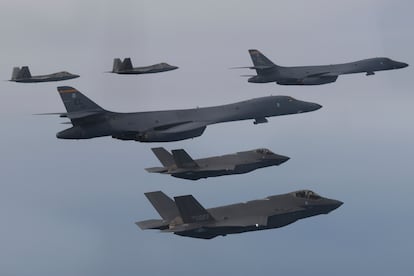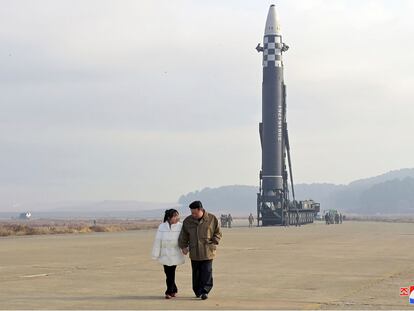North Korea warns of ‘overwhelming nuclear force’ to counter US
Kim Jong-un could showcase his growing arsenal of nuclear-capable missiles next week as commercial satellite images indicate preparations for a huge military parade in Pyongyang

North Korea said Thursday it’s prepared to counter US military moves with the “most overwhelming nuclear force” as it warned that the expansion of the United States’ military exercises with rival South Korea is pushing tensions to an “extreme red line.”
The statement by Pyongyang’s Foreign Ministry came in response to comments by US Defense Secretary Lloyd Austin, who said Tuesday in Seoul that the United States would increase its deployment of advanced military assets to the Korean Peninsula, including fighter jets and aircraft carriers, as it strengthens joint training and operational planning with South Korea.
South Korea’s security jitters have risen since North Korea test-fired dozens of missiles in 2022, including potentially nuclear-capable ones designed to strike targets in South Korea and the US mainland.
In a statement attributed to an unidentified spokesperson of its Foreign Ministry, North Korea said the expansion of the allies’ drills is threatening to turn the Korean Peninsula into a “huge war arsenal and a more critical war zone.” The statement said the North is prepared to counter any short- or long-term military challenge with the “most overwhelming nuclear force.”
“The military and political situation on the Korean Peninsula and in the region has reached an extreme red line due to the reckless military confrontational maneuvers and hostile acts of the US and its vassal forces,” the spokesperson said.
North Korea for decades has described the United States’ combined military exercises with South Korea as rehearsals for a potential invasion, although the allies have described those drills as defensive.
South Korea’s Defense Ministry said the United States flew B-1B bombers and F-22 and F-35 fighter jets in an exercise Wednesday with South Korean fighters above South Korea’s western waters. The United States and South Korea are also planning to a joint simulation this month aimed at sharpening their response if North Korea uses nuclear weapons.
The North Korean statement portends another provocative run in weapons demonstrations in 2023, similar to how the North ramped up its own weapons launches in 2022 as the allies resumed their large-scale training. North Korea’s actions included a slew of missile and artillery launches that it described as simulated nuclear attacks on South Korean and US targets.
“DPRK will take the toughest reaction to any military attempt of the US on the principle of ‘nuke for nuke and an all-out confrontation for an all-out confrontation!’” the North Korean spokesperson said, invoking the country’s formal name, the Democratic People’s Republic of Korea.
“If the US continues to introduce strategic assets into the Korean Peninsula and its surrounding area, the DPRK will make clearer its deterring activities without fail according to their nature,” the spokesperson said.
When asked about the North Korean statement in the Philippines on Thursday, Austin said the United States is “very serious” about its commitment to defending South Korea and will continue to work alongside its allies and “train and ensure that we maintain credible and ready forces.”
Ahn Eunju, spokesperson of South Korea’s Foreign Ministry, said North Korea’s expansion of its nuclear weapons and missile program and verbal threats of preemptive nuclear attacks have forced Seoul to react sternly to ensure the protection of its citizens.
“North Korea is the one that’s elevating tensions on the Korean Peninsula by rejecting dialogue offers from South Korea and the United States and making nuclear and missile provocations and threats,” she said, urging Pyongyang to return to denuclearization talks.
Jeon Ha Gyu, spokesperson of South Korea’s Defense Ministry, said the allies’ latest aerial drills were aimed at demonstrating the credibility of the US “extended deterrence,” referring to a commitment to use the full range of its military capabilities, including nuclear ones, to defend South Korea. He declined to reveal the exact number of US and South Korean aircraft involved in the exercise.
In a news conference following their meeting on Tuesday, Austin said he and South Korean Defense Minister Lee Jong-Sup agreed to further expand their combined military exercises, including more live-fire demonstrations. They pledged to continue a “timely and coordinated” deployment of US strategic assets to the region.
The allies had previously downsized their training in recent years to create room for diplomacy with North Korea during the Trump administration and because of the Covid-19 pandemic.
South Korea and the United States have also been strengthening their security cooperation with Japan, which recently included trilateral missile defense and anti-submarine warfare exercises during a provocative run in North Korean weapons tests.
“We deployed fifth-generation aircraft, F-22s and F-35s, we deployed a carrier strike group to visit the peninsula. You can look for more of that kind of activity going forward,” Austin said.
Tensions could further rise with North Korean leader Kim Jong-un doubling down on his nuclear ambitions.
During a political conference in December, Kim called for an “exponential increase” in nuclear warheads, mass production of battlefield tactical nuclear weapons targeting South Korea, and the development of more powerful long-range missiles designed to reach the US mainland.
Kim could showcase his growing arsenal of nuclear-capable missiles next week as commercial satellite images indicate preparations for a huge military parade in capital Pyongyang, likely for the 75th founding anniversary of its army that falls on Feb. 8.
Experts say Kim’s nuclear push is aimed at forcing the United States to accept the idea of North Korea as a nuclear power so it can negotiate badly needed economic concessions from a position of strength. Nuclear negotiations between the US and North Korea stopped in 2019 because of disagreements over a relaxation of US-led economic sanctions against the North in exchange for steps by North Korea to wind down its nuclear weapons and missiles programs.
The North Korean spokesperson said Pyongyang isn’t interested in any contact or dialogue with the United States as long as it maintains its “hostile policy and confrontational line,” saying Washington is trying to force Pyongyang to “disarm itself unilaterally.”
Sign up for our weekly newsletter to get more English-language news coverage from EL PAÍS USA Edition
Tu suscripción se está usando en otro dispositivo
¿Quieres añadir otro usuario a tu suscripción?
Si continúas leyendo en este dispositivo, no se podrá leer en el otro.
FlechaTu suscripción se está usando en otro dispositivo y solo puedes acceder a EL PAÍS desde un dispositivo a la vez.
Si quieres compartir tu cuenta, cambia tu suscripción a la modalidad Premium, así podrás añadir otro usuario. Cada uno accederá con su propia cuenta de email, lo que os permitirá personalizar vuestra experiencia en EL PAÍS.
¿Tienes una suscripción de empresa? Accede aquí para contratar más cuentas.
En el caso de no saber quién está usando tu cuenta, te recomendamos cambiar tu contraseña aquí.
Si decides continuar compartiendo tu cuenta, este mensaje se mostrará en tu dispositivo y en el de la otra persona que está usando tu cuenta de forma indefinida, afectando a tu experiencia de lectura. Puedes consultar aquí los términos y condiciones de la suscripción digital.
More information
Archived In
Últimas noticias
Sinaloa Cartel war is taking its toll on Los Chapitos
Venezuela hardens its ‘revolutionary state’ project amid pressure from Trump
Sydney Sweeney, the actress praised by Trump: ‘Women are up against what society wants them to be’
The Bolsonaro surname: An advantage or liability in Brazil’s 2026 presidential elections?
Most viewed
- Reinhard Genzel, Nobel laureate in physics: ‘One-minute videos will never give you the truth’
- Pablo Escobar’s hippos: A serious environmental problem, 40 years on
- Charles Dubouloz, mountaineering star, retires at 36 with a farewell tour inspired by Walter Bonatti
- Why we lost the habit of sleeping in two segments and how that changed our sense of time
- The fall of a prolific science journal exposes the billion-dollar profits of scientific publishing










































